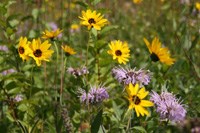|
While I know the standard claim is that Yosemite, Niagara falls, the upper Yellowstone and the like, afford the greatest natural shows, I am not so sure but the Prairies and Plains, while less stunning at first sight, last longer, fill the esthetic sense fuller, precede all the rest, and make North America’s characteristic landscape. -Walt Whitman A Vanishing Ecosystem Because the climate in which tallgrass prairie occurs naturally is also favorable to agriculture, much of the tallgrass prairie today has been converted to farm fields of one kind or another. Only a tiny sliver of the tallgrass prairie remains, less than 1 or 2% of the former range. Some of that prairie is within Pipestone National Monument. 
NPS Photo by Nathan King Diversity and Management Historically, in addition to massive herds of grazing bison, fire played a necessary role in the health of the prairie. Vital nutrients that might take years to decay were released into an ash that prairie plants could quickly start using and leaf litter was removed to allow sunlight to reach new shoots. Invasive species and trees that blocked out light and competed for nutrients were burned away so that prairie grasses, some with roots 12' deep or more, could grow more freely and unencumbered. |
Last updated: March 31, 2020
